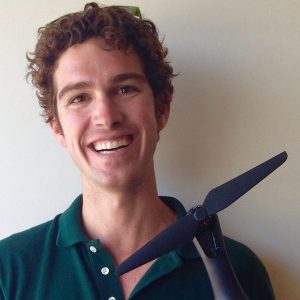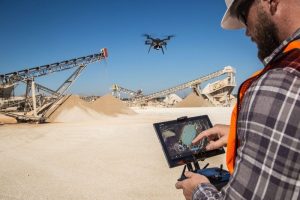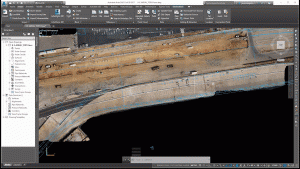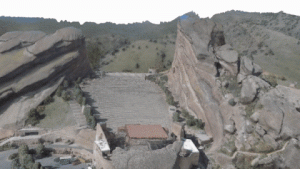
As the VP of Product for 3D Robotics (3DR), Daniel McKinnon works at the bleeding edge of UAV technology and AEC. 3DR recently raised US$53 million with which they will continue to develop their flagship product, Site Scan, an intuitive application for autonomous drone scanning that seamlessly integrates with the Autodesk software ecosystem.
McKinnon made the leap from attending AU to speaking at AU in 2016 with the class, From Site Scan to InfraWorks 360: Aerial Drone Scans for Planning and Design. Here he lets us in on how attending AU improves his competitive advantage, and how autonomous cars are unlikely inspiration for 3DR’s business model.
What is most exciting about reality capture and UAVs right now?
Reality capture is becoming real on the job site. UAV and laser scanning is no longer a science fair project for VDC groups, but a standard practice that is scaling across all types of complex projects. It took BIM 30 years to reach mainstream adoption, laser scanners 20 years, and UAVs less than 10. From WeWork’s commitment to 3D scanning each new project to PCL Construction transforming their surveying workflow with drones, major firms all over the world are turning to terrestrial and aerial reality capture to decrease costs, win bids, and increase safety.
How are these developments significant for the AEC industry?
Autodesk began creating beautiful tools for design decades ago, but the pretty CAD or BIM model was never quite replicated in the field. Reality capture via scanner or drone enables the constructor to feed the as-built back into the digital model and the designer to ensure that he is working with up-to-date existing conditions.
How is 3DR working to solve industry pain points?
Designers working with outdated surfaces or constructors relying on pen and paper for RFIs, change orders, or progress tracking represent major pain points in this $8 trillion industry where cost and time overages are the norm. With 3DR Site Scan, designers can quickly and easily scan a potential project before beginning work and ensure designs are based on actual existing conditions, rather than an outdated survey, satellite image, or set of blueprints. We recently saw this exact workflow implemented for the replacement of the historic Pinto Creek Bridge in Arizona.
On the build side, Site Scan allows constructors to digitize the entire job site as it evolves. This digital creation can be compared with the BIM or CAD model, from which deviations can be easily identified and processed into change orders or RFIs. We recently published a piece—“How Drone Data Delivers Bottom Line Value for SMBs in Construction”—explaining how Bogh Engineering has done just this for their earthworks contracts.

Tell us about the product design challenges 3DR faces when designing UAVs for AEC.
Designing for the UAV as a tool is a really interesting challenge. There are actually 2 user experiences to consider: the in-flight pilot experience and the tool to analyze data captured during that flight. The first experience is completely new for a lot of our users, and the second needs to seamlessly integrate into products they already use. We want to make these experiences as fluid as possible and ensure they fit into our user’s critical path.
Firstly, UAVs can be intimidating to new audiences, so we always put ourselves in the place of our users and make sure they feel empowered to fly. For example, if a drone is capturing a corner of a building, it might stop in mid-air to rotate. In our flight app our designs reflect this exact motion with a video in the top right corner so our users can see what is actually happening.
Secondly, another product design challenge in AEC is understanding the products that our users interact with in their existing BIM workflow. We study how our customers use these products during user research and testing, and integrate similar conventions into our Manager tool.
How have your AU experiences impacted your work? What have you gained through them?
I have attended AU for the past 2 years. Each of those represented an incredible opportunity to connect with forward-looking designers interested in how they stand to benefit from new technology. Through conversations at AU we have edited our roadmap, repositioned our product, opened new channels, and connected with customers new and old.

How would you say that attending and speaking at AU improves your competitive advantage?
Speaking at AU is a must for anyone building construction technology. Not only will the audience push and encourage you, the badge of speaking at AU serves to open doors throughout the following year. The AEC industry looks to Autodesk for thought leadership and innovation and an AU speaker tag serves as an implicit Autodesk endorsement of an idea or workflow.

You’re part of a new generation of engineers, designers, and all-round innovators. What other industries are pushing you and your work?
As Marc Andreessen so eloquently quoth, “software is eating the world.” Technology is impacting every industry on the planet and we are excited to be part of the movement to bring new tools to AEC. We won’t stop and will broaden our focus until Site Scan evolves into a tool as robust and accepted as a hammer or a drill, but we draw inspiration from innovators across verticals.
In particular, we love how quickly the major players in autonomous cars have transitioned from purely research teams to serious companies shipping serious products for mass consumption.

What advice would you give tomorrow’s engineers?
The advice I’d like to pass to tomorrow’s engineers and innovators is simple: identify a problem and build a solution, not the other way around.
—
Daniel McKinnon is vice president of Product at 3D Robotics (3DR). 3DR makes advanced drone technology easily accessible to the construction, mining, and surveying industries for use in data analysis, mapping, 3D modeling, and more. McKinnon has worked closely with the Autodesk ReCap team to build Site Scan. Site Scan enables Autodesk customers to generate aerial imagery, orthophotos, point clouds, or meshes for infrastructure planning, construction monitoring, and myriad other uses. Reality capture from the sky—made possible by advancements in drone technologies like Site Scan—is helping bridge the gap between as-designed and as-built. 3DR is a portfolio partner of Autodesk, Inc. and a recipient of the Autodesk Forge Fund.



